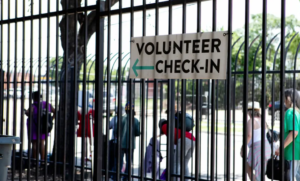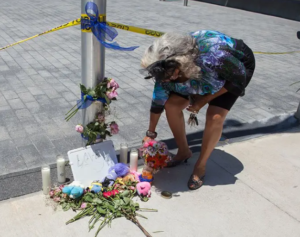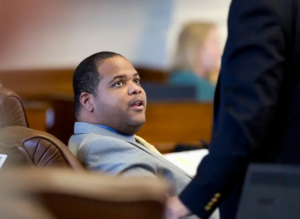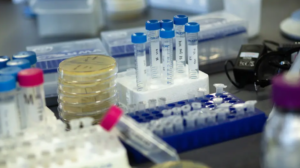A Bad Dream: New York Children Who’ve Lost Parents to COVID-19 Face Hardships Beyond Grief
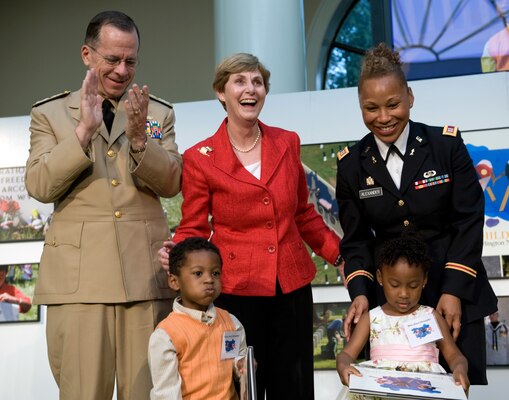
Catherine Abear has one family photo of the four of them: herself, her husband Ray, and their 2-year-old son and then 1-month daughter, all together, taken on Christmas Eve.
Three months later, COVID moved Ray into the basement of their Jamaica, Queens, house, to quarantine. He was there for nine days, and then for four in the hospital, where he died.
“It seems like a bad dream still,” Catherine Abear said.
Ray Abear, a 43-year-old NYPD detective, was among the untold number of mothers, fathers and other primary caregivers whom the coronavirus has claimed since tearing through the city this spring.
There is no official count of New York children who have lost a parent or caregiver to the virus — and even less idea of how the city will help support the likely hundreds or more kids who have suddenly suffered a life-altering loss.
Coronavirus has killed more than 23,000 people across the five boroughs, with 5,985 confirmed and probable deaths in the 18-to-64 age group that encompasses most parents of children under 18.
Older New Yorkers also play a prominent role as primary caregivers: Citywide, nearly 10% of families with children are headed by grandparents — a figure that’s higher in some neighborhoods where the pandemic hit hard. More than 16,000 New Yorkers age 65 and older have died of COVID-19.
Unions Hint at Scope
Records compiled by local labor unions hint at the scale of children’s loss. Transport Workers UnionLocal 100 members killed by COVID-19 have left behind approximately three dozen next of kin under 18, the union said.
Twenty-one in-service members of the United Federation of Teachers — out of 69 who died — leave 32 surviving children 18 or under. Of the 85 New York City members of SEIU 32BJ who have died since March, 34 had children who depended on them, 49 kids in all. The union represents building cleaners and doormen.
Twenty-seven of the 39 active members who died from Teamsters Local 237 — school safety agents, NYCHA caretakers and other city workers — had dependent children.
The city Administration for Children’s Services has so far placed eight children from five families in foster care — mostly with kin — after the death of a primary caregiver from COVID-19.
Read the stories of some who died from the coronavirus — and help THE CITY tell the stories of thousands more.
While some enter foster care, more children typically come under the care of non-parent caregivers, from grandparents to aunts to older siblings and close family friends, without that designation — or the supports or stipends that come with it.
“In the small number of cases where parents are unable to make arrangements themselves, ACS ensures their children are safely cared for by identifying a relative, family friend, or where necessary a foster home,” said Marisa Kaufman, an ACS spokesperson.
The agency has also created a resource page encouraging parents to make a plan for their children in the event that they get sick.
Long-term Concerns
Families dealing with the loss of a parent or caregiver already faced a multitude of challenges, some now compounded by the pandemic.
On April 14, the day after Ray Abear died, Catherine, also sick with COVID, had to get a chest X-ray. Her brother, who is asthmatic, stood over her car watching her 2-year-old and then-4-month-old while she ran into an urgent care clinic.
She was told she would have to pay out of pocket because Ray’s insurance had been cut off when he died. His union, the Detectives’ Endowment Association, helped her get the benefits extended.
Still, the 37-year-old homemaker now faces a cluster of daunting new demands, from finances to emergency plans to the challenge of explaining death to her children.
“I spoke with a grief counselor, because you want to make sure you say the right thing to your children, like you don’t want to say, um, ‘Daddy was sick and now he’s never gonna come home again,’” she said.
She hopes that down the line her kids will have access to counseling and support groups if they need them.
“You don’t really know how things like this will affect them in the years to come,” she said.
‘A Little Less Alone’
A handful of programs in the city provide emotional support to kids dealing with a death. The gold standard response for grieving kids is a support group, generally a short-term meeting of youths in their age range, experts say.
Kids benefit from meeting other kids who are like them, said Carolyn Taverner, a psychologist at Emma’s Place, a family and children bereavement-focused nonprofit in Staten Island.
“When you’ve suffered a loss, it automatically makes you different from the other kids, and that’s the worst thing in the world to be when you’re a kid is ‘different from everybody else,’” she said. “So this is a place where they feel a little less alone.”
Nonprofits including The Jewish Board, Calvary Hospital and A Caring Hand, which was started by a woman who lost her dad on 9/11, also run such groups. But capacity is limited, providers said.
Maria Georgopoulos, director of bereavement services at Calvary Hospital, in The Bronx, said most of their groups are already full, and she is seeing a spike in requests for services from people of all ages dealing with coronavirus deaths.
Direct inquiries from clients looking for help have recently nearly doubled to 150 a week, and groups and agencies are calling for help about 40 times a week, up from the usual five, she said.
“I’ve been getting a lot of calls from schools,” she said. “They don’t really know what to do with all the loss in their communities.”
She is trying to refer clients out as her groups max out.
“More funding would be needed to be able to do more,” she said.
A Need for Services
Crystal Gauen, an art therapist on the child loss and bereavement team at the Jewish Board, said an expansion is needed to meet the demand.
“The infrastructure for child and adolescent bereavement services in the city is already not big enough,” she said.
Another challenge lies in more comprehensively linking kids and families with services. It often falls to teachers to make the connection, providers said.
The Department of Education does not track the number of children who have lost a parent or caregiver, a spokesperson said.
“We are providing crisis counseling and support through our crisis teams and social workers to any student and school community who needs mental health help during this time,” the spokesperson, Nathaniel Styer, wrote in an email.
School Crisis Teams connect students with services, he said, and, if requested, schools deploy social workers to provide immediate clinical mental health services and referrals to long-term services.
It is not yet clear what the particular circumstances of the pandemic will mean for grieving kids. Generally, routine is important for them, experts said, and returning to school is normalizing and helpful.
But the usual rituals, from funerals to neighbors delivering food, have been disrupted.
The city should track the number of kids who have lost parents and caregivers, with an eye to providing some help, said City Councilmember Debi Rose (D-Staten Island), who chairs the Youth Services Committee.
“First we have to collect the data, first we have to know that there are some dependent children somewhere that have now lost their parent,” she said.
“There has to be some sort of continuum, some sort of follow-up so that the needs can be met and so that they don’t fall through the cracks.”
The article was published at A Bad Dream: New York Children Who’ve Lost Parents to COVID-19 Face Hardships Beyond Grief
